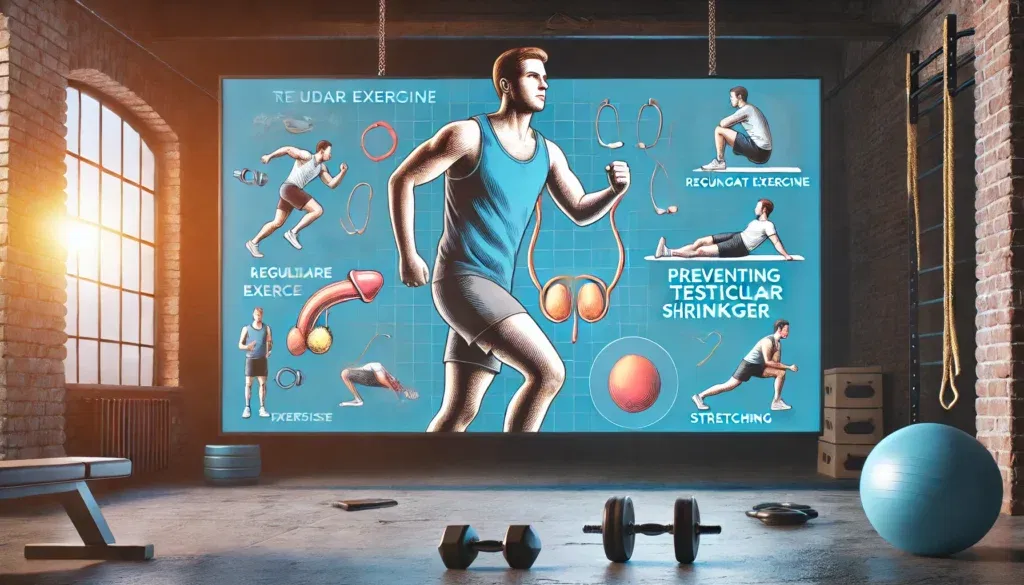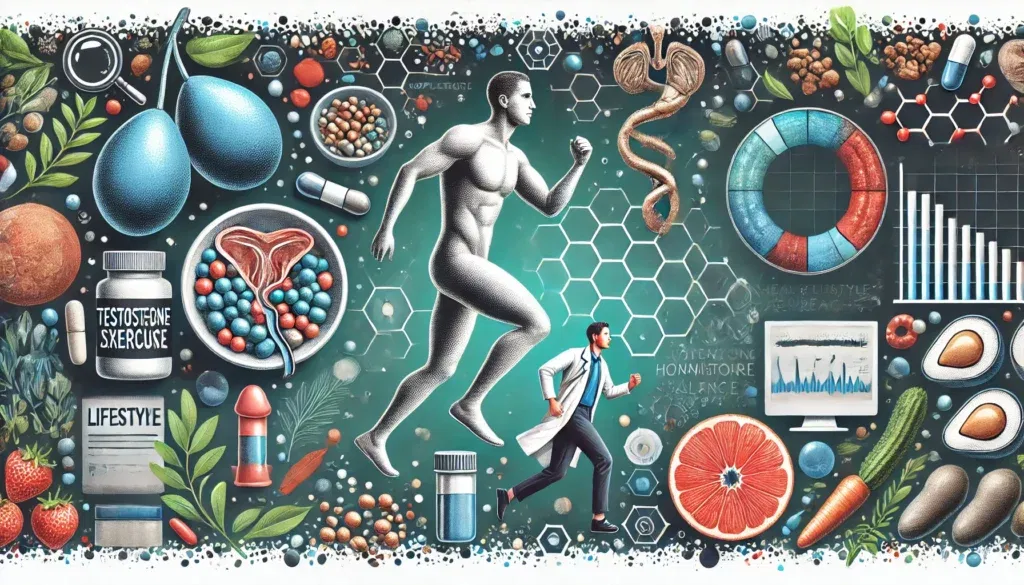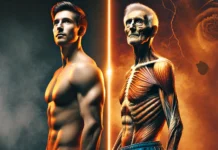Understanding Testicular Shrinkage on Testosterone Therapy
Testosterone replacement therapy (TRT) is a widely used treatment for men with low testosterone levels, helping to restore vitality, muscle mass, and overall well-being. However, a common concern among users is testicular atrophy, or the shrinking of the testes, which often accompanies exogenous testosterone use. This occurs because when the body receives testosterone from an external source, it suppresses the production of gonadotropins—luteinizing hormone (LH) and follicle-stimulating hormone (FSH)—which are essential for natural testosterone production and sperm formation. Without stimulation from these hormones, the testicles may shrink and reduce their function.
You may also like: How to Increase Testosterone Levels Naturally: Science-Backed Strategies for Men’s Health & Longevity
For men considering TRT, it is crucial to understand why testosterone can cause this effect and explore ways to counteract it effectively. The good news is that testicular shrinkage is not inevitable, and with the right approach, it can be minimized or even prevented. Various medical strategies, supplements, and lifestyle interventions can help maintain testicular size and function while on TRT.

The Science Behind Why Testosterone Shrinks Your Balls
When exogenous testosterone enters the body, it disrupts the hypothalamic-pituitary-gonadal (HPG) axis, which regulates natural hormone production. Normally, the hypothalamus signals the pituitary gland to release LH and FSH, which in turn stimulate the testes to produce testosterone and sperm. However, when TRT provides an external source of testosterone, the brain perceives that sufficient levels exist, shutting down LH and FSH production. Without these signals, the testes reduce their function, leading to a decrease in size and sperm production.
This biological response is the primary reason why testosterone shrinks your balls, and it is a well-documented effect in medical literature. The extent of shrinkage varies among individuals, depending on the dosage, duration of therapy, and genetic predisposition. Some men may experience minimal changes, while others notice a significant reduction in testicular size over time. Fortunately, there are medical interventions and lifestyle choices that can counteract this response and help maintain testicular health.
Proven Supplements for Testicular Atrophy Prevention
To combat testicular shrinkage, many men turn to proven supplements for testicular atrophy. These supplements work by either stimulating the body’s natural production of LH and FSH or by directly supporting testicular health. Among the most effective options are:
Human Chorionic Gonadotropin (hCG)
Human chorionic gonadotropin (hCG) is a powerful agent that mimics LH in the body, signaling the testes to continue producing testosterone and sperm even while on TRT. Studies have shown that incorporating hCG into a testosterone regimen can prevent or even reverse testicular shrinkage. hCG is often prescribed in doses ranging from 500 to 2,000 IU per week, depending on individual needs.
Clomiphene Citrate (Clomid)
Clomiphene citrate is a selective estrogen receptor modulator (SERM) that works by blocking estrogen receptors in the brain, leading to an increase in LH and FSH production. Unlike hCG, which directly stimulates the testes, Clomid encourages the body’s own natural production of these crucial hormones. Some men use Clomid as an alternative to TRT, while others incorporate it into their protocol to maintain fertility and testicular size.
Enclomiphene Citrate
Enclomiphene is a purified isomer of Clomid that specifically stimulates LH and FSH without the mixed estrogenic effects associated with Clomid. It is becoming a preferred option for men looking to prevent testicular atrophy while on TRT. Studies indicate that enclomiphene is particularly effective in maintaining sperm production and natural testosterone synthesis.
D-Aspartic Acid (DAA)
D-Aspartic Acid is a naturally occurring amino acid that plays a role in the production of LH and testosterone. Some studies suggest that DAA supplementation can enhance endogenous testosterone production, making it a potential tool for men looking to mitigate the effects of TRT on testicular function.
Zinc and Vitamin D
Zinc is essential for testosterone synthesis and testicular function. A deficiency in zinc can impair testosterone production, making supplementation beneficial, particularly for men on TRT. Vitamin D also plays a crucial role in hormone regulation, and maintaining optimal levels can support overall testicular health.
Lifestyle Strategies to Prevent Testicular Shrinkage
While medical interventions are highly effective, lifestyle choices also play a significant role in preserving testicular function. Incorporating the following strategies can help counteract testicular atrophy:
Regular Resistance Training
Strength training has been shown to naturally boost testosterone levels and improve overall hormonal health. Engaging in compound movements such as squats, deadlifts, and bench presses can stimulate endogenous testosterone production, complementing TRT and reducing the impact of exogenous testosterone on the testes.
Intermittent Fasting and Diet Optimization
Intermittent fasting has been linked to improved hormone regulation, including increased LH and testosterone levels. Additionally, a diet rich in healthy fats, lean proteins, and essential micronutrients supports testicular function. Omega-3 fatty acids, found in fish and flaxseeds, contribute to optimal testicular health, while antioxidants from fruits and vegetables help combat oxidative stress.
Avoiding Excessive Estrogenic Compounds
Environmental estrogens, found in plastics, pesticides, and certain foods, can disrupt hormonal balance and exacerbate testicular shrinkage. Avoiding processed foods, reducing plastic exposure, and consuming cruciferous vegetables like broccoli and cauliflower can help regulate estrogen levels and support testosterone balance.
Managing Stress and Optimizing Sleep
Chronic stress and poor sleep quality can negatively impact hormone levels, further exacerbating the effects of TRT on testicular health. Implementing stress management techniques such as meditation, deep breathing, and adequate sleep hygiene can significantly improve hormonal balance and overall well-being.
Does Low Testosterone Shrink Your Balls?
Many men wonder, “Does low testosterone shrink your balls?” The answer is that while low testosterone can lead to testicular shrinkage, the primary driver of atrophy is the absence of LH and FSH stimulation. When testosterone levels decline naturally due to aging or medical conditions, testicular size may decrease slightly, but the effect is usually not as pronounced as when exogenous testosterone completely suppresses gonadotropin production. This is why maintaining some degree of natural hormone stimulation, even while on TRT, is crucial for preserving testicular function.

Frequently Asked Questions (FAQ) on Testosterone and Testicular Health
1. Why does testosterone shrink your balls?
Testosterone therapy can lead to testicular shrinkage due to a reduction in natural hormone production. When the body receives external testosterone, the brain signals the testes to produce less, leading to atrophy over time. The testes rely on luteinizing hormone (LH) and follicle-stimulating hormone (FSH) to function, both of which are suppressed when synthetic testosterone is introduced. This process is commonly referred to as hypogonadism. The extent of shrinkage varies from person to person, depending on dosage, duration of use, and individual physiology.
2. Does testosterone shrink your balls permanently?
For many individuals, testicular shrinkage from testosterone use is reversible once therapy is discontinued. However, in cases of long-term use or high dosages, some degree of atrophy may persist. Post-cycle therapy (PCT) with medications like clomiphene citrate (Clomid) or human chorionic gonadotropin (hCG) can help stimulate natural hormone production. Maintaining a balanced diet and engaging in resistance training can also support recovery. Consulting a medical professional before stopping testosterone therapy is essential to ensure a safe transition.
3. How to prevent testicular shrinkage on testosterone?
One effective strategy is the use of hCG alongside testosterone therapy. hCG mimics LH, which helps keep the testes active and reduces atrophy. Another approach is cycling testosterone with natural boosters to allow endogenous production to recover periodically. Maintaining a healthy lifestyle with adequate sleep, exercise, and a nutrient-rich diet can also support testicular function. Avoiding excessive alcohol and managing stress levels can further promote hormonal balance. Always work with a healthcare provider to tailor a protocol that minimizes side effects.
4. Can low testosterone shrink your balls?
Yes, low testosterone levels can contribute to testicular shrinkage, as insufficient hormonal stimulation leads to reduced function. Conditions such as hypogonadism, aging, and chronic illnesses can lower testosterone and impact testicular size. Lifestyle factors, including obesity, stress, and poor sleep, can exacerbate this issue. Addressing low testosterone through medical intervention, lifestyle modifications, or proven supplements for testicular atrophy can help restore testicular health. Regular monitoring of hormone levels is essential for early detection and management.
5. Are there proven supplements for testicular atrophy?
Yes, several supplements have shown promise in supporting testicular health. D-aspartic acid (DAA) can help stimulate natural testosterone production. Zinc and magnesium are crucial for hormone balance and testicular function. Adaptogenic herbs like ashwagandha and tongkat ali have been linked to improved testosterone levels. Omega-3 fatty acids and vitamin D can support overall endocrine health. Always choose high-quality, clinically tested supplements and consult a healthcare professional before starting any new regimen.
6. Does age-related testosterone decline affect testicular size?
As men age, natural testosterone production declines, which can lead to testicular shrinkage in some cases. This process is often gradual and accompanied by symptoms such as reduced energy, lower libido, and decreased muscle mass. While some men opt for testosterone replacement therapy (TRT), others prefer lifestyle interventions to slow this decline. Regular resistance training, a nutrient-rich diet, and stress management can help maintain hormonal balance. Addressing age-related testosterone decline proactively can help preserve testicular function.
7. How does testosterone therapy impact fertility?
Exogenous testosterone can significantly reduce sperm production, as it suppresses FSH and LH, which are critical for sperm development. This can lead to temporary or prolonged infertility, depending on the duration of use. Men concerned about fertility may use hCG or selective estrogen receptor modulators (SERMs) to mitigate these effects. If fertility is a priority, consulting a reproductive specialist before starting testosterone therapy is crucial. Many men successfully restore sperm production after discontinuing testosterone with proper medical guidance.
8. Can testicular shrinkage be reversed naturally?
Yes, in many cases, testicular shrinkage can be reversed naturally, especially if caught early. Discontinuing testosterone use and implementing a structured recovery plan, including PCT, can restore natural function. Engaging in high-intensity exercise, particularly strength training, can naturally boost testosterone levels. Optimizing sleep and reducing stress can also enhance hormone production. Natural testosterone boosters, including certain herbs and micronutrients, may support the recovery process.
9. How long does it take for testicles to recover after stopping testosterone?
Recovery time varies based on the duration of testosterone use, dosage, and individual factors. Some men may notice improvements within a few months, while others take a year or longer to regain full function. PCT, including medications like Clomid or Nolvadex, can accelerate recovery. A well-balanced diet, exercise, and proper supplementation can further support the process. Regular bloodwork is recommended to track hormone levels and ensure a smooth recovery.
10. What lifestyle changes can help prevent testicular shrinkage?
Maintaining a healthy diet rich in essential nutrients is key to hormonal balance. Regular exercise, particularly weight training, can naturally boost testosterone production. Prioritizing sleep and managing stress levels are crucial for endocrine health. Avoiding excessive alcohol, processed foods, and environmental toxins can further support testicular function. Combining these habits with proven supplements for testicular atrophy can help maintain optimal reproductive health.

Conclusion: Maintaining Testicular Health on TRT
Preventing testicular shrinkage while on testosterone therapy is possible with the right combination of medical strategies, supplements, and lifestyle modifications. Understanding why testosterone shrinks your balls is the first step in addressing this concern. Proven supplements for testicular atrophy, such as hCG, Clomid, and D-Aspartic Acid, can help stimulate endogenous hormone production and support testicular function. Additionally, maintaining a healthy lifestyle through exercise, proper nutrition, and stress management plays a crucial role in hormonal balance. By integrating these strategies, men on TRT can preserve testicular health, fertility, and overall well-being while reaping the benefits of optimized testosterone levels.
testosterone replacement therapy side effects, preserving testicular health, boosting natural testosterone production, HCG for TRT, fertility and testosterone therapy, Clomid vs Enclomiphene, hormone optimization strategies, intermittent fasting for testosterone, best supplements for testicular health, exercise and testosterone levels, stress management and hormones, environmental estrogens effects, zinc for testosterone production, vitamin D and testosterone, anabolic steroids vs TRT, LH and FSH stimulation, hormonal balance and longevity, avoiding testicular shrinkage, natural ways to increase LH, optimizing TRT protocols
Further Reading:
What Men Should Know About Testicular Shrinkage and Testosterone Therapy
The benefits and risks of testosterone replacement therapy: a review
Options for Increasing Your Testosterone
Disclaimer: The information provided in this article is for general informational purposes only. The content does not constitute professional advice of any kind, including but not limited to medical, legal, or financial advice. HisHealthMag and its contributors make no representations or warranties regarding the accuracy, completeness, or reliability of the information presented. Always seek the advice of a qualified professional for any specific concerns or questions you may have. Neither HisHealthMag nor its authors assume any responsibility or liability for any actions taken based on the information provided in this article. The views and opinions expressed are those of the author(s) and do not necessarily reflect the official policy or position of HisHealthMag.





